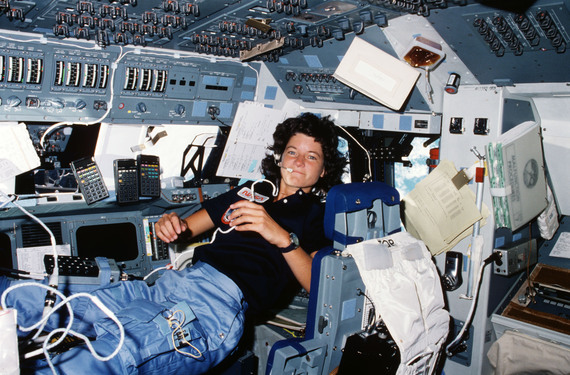By some accounts, the existence of gender discrimination in science is a shock. For the women themselves, it’s a long-suffered truth. Statistically, women remain underrepresented in most areas of science at every level, from undergraduate courses all the way through to professorships. Despite how far we’ve come, there’s a lot further to go, as these stories from women we met exhibiting at London’s New Scientist Live exposition in September highlight.
First up is Emma Wride, a Space Ambassador for her native Wales, who went straight into hairdressing after leaving school, because “that’s what girls did”. A lover of space science and astronomy since childhood, her passion eventually got the better of her in her thirties, when she went back to school and then onto university to study for a degree in astronomy. Today, she tours the country encouraging the next generation to get involved in science. She is forceful when we ask why she is passionate about getting women into science: “because,” she says, “if they want to be whatever they want to be, they can be. And they don’t have to do hairdressing just because they’re a girl.”
The idea that girls have one type of career while boys have another – as much as we might think it something of the past – persists, not only across generations but across countries. “We need more girls to do ‘boys’ jobs'”, says Lidia Gabarrini, a drone operator and repair technician for the company Extreme Fliers. The women in her family never accepted traditional gender roles – her mother drove “a huge truck” – and so Gabarrini grew up oblivious to the idea that some career paths might be blocked to her on the grounds of her gender.

Women are underrepresented within electronic engineering. Source: Wikimedia Commons.
Unfortunately, the attitudes she encounters in her job make it clear that not everyone is equally oblivious. “When I do shows, people say ‘oh my god, a girl can fly a drone, she can repair drones, it’s so cool!'”, she says. “Yes, because we can do everything.” But, as the only woman in her company that flies and repairs drones, she faces an uphill struggle: as a woman, she says, she has to work much harder than her colleagues to prove herself. “It’s very challenging, because it’s a man’s world.”
This is a sentiment that is echoed across industries where men have traditionally dominated the workforce. The field of spaceflight, in particular, is notable for the bemusement with which it greeted the arrival of female astronauts – Sally Ride was famously asked if one hundred tampons would be enough for seven days in space – and, for many women, this lack of accommodation can be career-threatening.

Sally Ride, the first American female astronaut, aboard the Challenger shuttle. Source: Wikimedia Commons.
Discrimination against women is, infuriatingly, not a thing of the past, and often forward strides in policy – which should be celebrated – unfortunately also serve to conceal attitudes that remain outdated and harmful. Science charity founder Amy King, who was sporting professional-standard hair and makeup – and in the midst of demonstrating complex thermo-chemical reactions to a crowd of children – when we met her, knows this better than most. At school, she heard that as a woman in science there were only two career options open to her: “to be a doctor if you’re brainy, and a nurse if you’re not.” Later, during her undergraduate interview for a prestigious university, she was told that she was too glamorous to be taken seriously as a scientist, and that “the ‘hair and beauty’ was down the road”.
“She was made to recite the periodic table from memory to prove that she was a scientist,” Nicola, her mother, recalls. “She got to about the third or fourth row down when they said she could stop there.” The university offered her a place; she turned it down, and went instead to the University of Greenwich, where she preferred the laboratory environment. Her experiences drove her to found the charity GlamSci, dedicated to helping disadvantaged young people achieve careers in STEM. Now a lecturer and STEM ambassador aiming to gain a PhD in medicinal chemistry, Amy is one of the Royal Society of Chemistry’s 175 Faces of Diversity alongside figures like Heston Blumenthal and Bill Bryson.
Success stories like this are common among the women we speak to; there is, of course, hope for science yet. Pallavi Chaturvedi, a clinical development manager at GlaxoSmithKline, says the story has begun to change in her lifetime: “When I was growing up there wasn’t that much knowledge of what career progression options there were [for women], and I think that’s changed a lot.” She highlights education as the “main thing” that will drive women to enter science: “having those focus groups, having those interactions,” she says, will help bring the vision of inclusive science to life. “There’s lots and lots of encouragement [now] for women to get into science,” agrees Emma Wride. But she’s not satisfied: “we [need] more women in science, and in higher roles – more professors is what we need to encourage the next generation.” Onwards and upwards.
— This feed and its contents are the property of The Huffington Post UK, and use is subject to our terms. It may be used for personal consumption, but may not be distributed on a website.